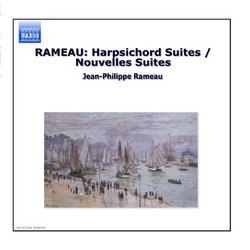Rameau's Harpsichord Suites
Robin Friedman | Washington, D.C. United States | 02/25/2006
(5 out of 5 stars)
"I have had this CD, recorded in 1990, by harpsichordist Alan Cuckston for many years and was inspired to revisit in upon hearing a recital of Rameau opera arias by the great French high tenor, Jean Fouchard, and the Opera Lafeyette at the University of Maryland. I discovered that this CD has been superceded in the Naxos catalogue by a recording of the Rameau's complete harpsichord music by Gilbert Rowland. No matter. This is still an excellent CD and a good introduction to Rameau.
Jean-Phillipe Rameau, (1683 -- 1764) was a contemporary of Bach and a master of French baroque music. He is best-known for his operas, which so pleased me at Fouchard's recital. Rameau did not become an opera composed until the age of 50, an inspiration for us late bloomers. But his harpsichord music, which is sometimes slighted, also has the ability to transport me to realms of the imagination with its clangor, majesty, linearity, and harmonic daring.
French baroque harpsichord music consists of two basic types of pieces: dance movements and character, genre pieces. Both are represented on this CD in two of Rameau's collections for harpsichord. He composed the "Premier Livre de Pieces de Clavecin" in 1706 as a young man of 23. The suite is in the key of A minor and consists of austure, well-integrated, imaginative writing including eight dance movements and a single section, "Venetienne", which is a portrait of gondoliers inspired by a ballet current during Rameau's time. Although Rameau was a baroque composer, this work is best known for its deeply textured, complex use of harmony, especially in the Prelude, the first allemande, and in the courante. But there is no need to be daunted by the fullness of Rameau's harmonic writing. The best way to hear this music is simply to listen and enjoy.
The second work on this CD is the much longer "Nouvelle Suites de Pieces de Clavecin" published in 1728, more than 20 years after the first suite. (Rameau's intervening "second book" is not included on this CD.) This is a more varied collection which includes dance movements, variations, character pieces, and individual compositions. The collection begins with a long, highly elaborate Allemande which combines different textures and tempos into a seamless whole. The overall impression of this movement is one of great clangor in the harpsichord and majesty.
The pieces I especially enjoyed in the "Nouvelle Suites" include the light, highly counterpointed "the three hands", and the short lively "La Triomphante" with its suprising harmonic shifts between major and minor keys. Rameau also wrote a piece called "the enharmonic" for this collection which illustrates how one note can be used as the basis for shifting from one key and mood to another. The character piece, "the sauvages", with a highly marked rhythm, is based upon the appearance of two Indians from Lousiana at a fair in Paris. Another character piece, the concluding work of the set, is "the Egyptian", a swirling work which describes the dancing of a gypsy girl. But my favorite portion of the "Nouvelle Suites" is the "Gavotte with six doubles (variations)." This music takes a stately, slow gavotte dance and develops in through six variations with great force, energy and virtuosity. It is a grand display of the beauty of the harpsichord.
Rameau's harpsichord music is both learned and accessible. I have long enjoyed this CD and was pleased to have the opportunity to return to it.
Robin Friedman"


 Track Listings (30) - Disc #1
Track Listings (30) - Disc #1